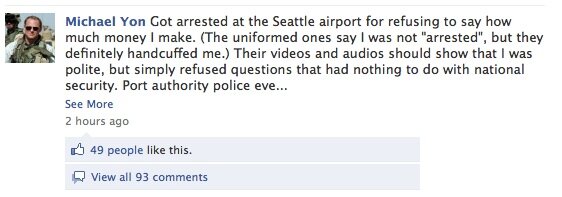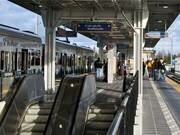Backscatter scan, courtesy TSA, leaves little about how it's hanging to the imagination.
Goldy at HorsesAss is having none of the full-body security scans starting up at SeaTac this September, claiming the invasion of privacy and safety concerns are just too much. (In March 2010, the TSA purchased 450 advanced imaging technology units with ARRA funds--at $130,000 to $170,000 each, says the Seattle Times.)
Regular surveillance cameras were enough to catch the TSA supervisor who stole $20,000 worth of valuables from checked luggage, but SeaTac, which has one of the more complex and inane security/performance art installations in the nation, has no problem with an invasive upgrade. (In fairness, they arbitrarily downgrade, too: "TSA Relaxes Restrictions for Cigarette Lighters and Breast Milk in Carry-On Luggage.")
Of the two types of imaging technology, millimeter wave and backscatter, it's the latter that has health professionals worried. Backscatter relies on low-dose x-rays just strong enough to "see through" clothes, but be reflected back by skin and soft tissue.
Health professionals are concerned that this kind of exposure directed at the skin could still have effects: "[T]here really is no threshold of low dose being OK. Any dose of X-rays produces some potential risk," David Agard, a biochemist and biophysicist at UCSF told NPR.
In an Orwellian touch of "sensitivity," the x-ray units employ a blurring algorithm while passengers are observed nude, and the TSA has instituted a complicated privacy procedure so that you will never actually see the officer checking you out nude:...
 Ex-Green Beret Michael Yon has been making a good living as an independent war correspondent, blogging his way through Iraq and Afghanistan, for some years now. He's been in the New York Times and the Wall Street Journal, on CNN and FOX News.
Ex-Green Beret Michael Yon has been making a good living as an independent war correspondent, blogging his way through Iraq and Afghanistan, for some years now. He's been in the New York Times and the Wall Street Journal, on CNN and FOX News.
But when he refused to tell "border bullies" (customs officials? TSA?) at the SeaTac airport how much money he made, they handcuffed him. He was eventually "rescued" by Port of Seattle police. "No country has ever treated me so badly," he added in another Facebook update, and included Afghanistan and Singapore in that list.
Airport security is understandably tight at the moment, following the Christmas Day failure to prevent a bomber from boarding not one but two flights. But it's difficult to see what self-reported income would add to airport security. And I'm not aware of any rules stating that U.S. citizens have to declare their income before being readmitted to the country.
Hey, welcome to Seattle, Michael!
As of 10 a.m. this morning, you can take light rail from downtown to the SeaTac Airport in 36 scenic minutes. There's enough space under most seats to stow baggage if you're holding carry-on in your lap. The fare is $2.50 one-way. Here's a photo gallery of our preview trip. (In other transit news, everyone wants a piece of the First Hill streetcar.)
On December 15, 2009, at 10:27 a.m., Boeing's 787 Dreamliner lifted off at Paine Field for a test flight. For three hours, it flew back and forth over the Sound, until increasingly rainy weather called a halt to the flight. Testing will continue for about nine months, and involve three 787s and about a dozen flight crew. Even Ryanair's brinksmanship on its huge 737 order couldn't dampen Boeing spirits.
Other local bidness: Weyerhauser announced it's becoming a real estate investment trust, McDonald's double-dog-dared Starbucks to provide free Wi-Fi, and the Seattle Times triumphed temporarily over death (taxes).
Seattle left last week's record low temperatures behind, and started focusing on eating outside. The Mobile Chowdown will return to Interbay on January 9. City Hall and SDOT are making street-food-friendly noises regarding regulatory changes in 2010, including making it easier for vendors to set up on the outskirts of city parks. We also mistakenly pumped 10 million gallons of sewage into Elliott Bay.
Sports fans had an early Christmas, discovering Husky QB Jake Locker, pitcher Cliff Lee, and hothead Milton Bradley under their tree.
As of 10 a.m. on Saturday, December 19, there will be a SeaTac light rail station open for business. For $2.50 (one-way), you can ride the full line from the Westlake station downtown to the airport, and the Central Link segment will be complete.
It's only a three-minute jaunt from the Tukwila station, where the line used to end, to the airport station, but it cost $268 million. (The whole trip from downtown takes about 36 minutes, and trains run every 7.5 to 15 minutes, depending on the time of day.) Besides its ahead-of-schedule opening--which was originally set for December 31--the airport station has come in under budget.
The Port of Seattle handed me a fact sheet on a media preview walk-through this morning, noting proudly that the road improvements associated with the station construction cost $10 million less than budgeted in Port funds, and the pedestrian bridge and walkway came in at $1.4 million less. Altogether it's 950 feet from the platform to the first terminal skybridge, which everyone is sensitive about.
You can arrange free wheelchair service from Huntleigh (call in advance 206-433-5287), but otherwise you're hoofing it. There will be baggage carts, but nothing for you to ride on. (A people-mover was ruled out because of logistical considerations--it wouldn't really fit--and extra expense.) You won't notice the length so much on your way in; it's the return trip, when you've already hiked a few miles through airports, that the extra quarter-mile will wear on you. Still, for transit riders, a hike was already in order to get to the bus stop south of the terminal.
The Port's SeaTac employees, interestingly, may provide a good deal of the light rail regular ridership. Some 22,000 people commute to work at the airport each day, and it's hoped that some will take the new train, in addition to travelers. I'm checking with the Port on how it currently encourages its employees to take transit, and if there will be a special light rail push.
UPDATE: Perry Cooper, the Port's media officer, says via email:
We can’t predict how many employees will move to riding light rail, but we have several Commute Trip Reduction qualified employers, including the Port, Alaska Air Group, Delta and Host (who run many of our concessionaires). Another one of the largest employee groups that may take advantage of light rail are the employees of TSA, who have a significant number of employees that utilize public transportation.
For the Port’s Aviation division here at Sea-Tac, we have approximately 280 employees that hold a FlexPass, which is good on King County Metro, Pierce County Transit and Sound Transit including the Link Light Rail. We continue to promote that throughout Port employees.


Most Recent Comments